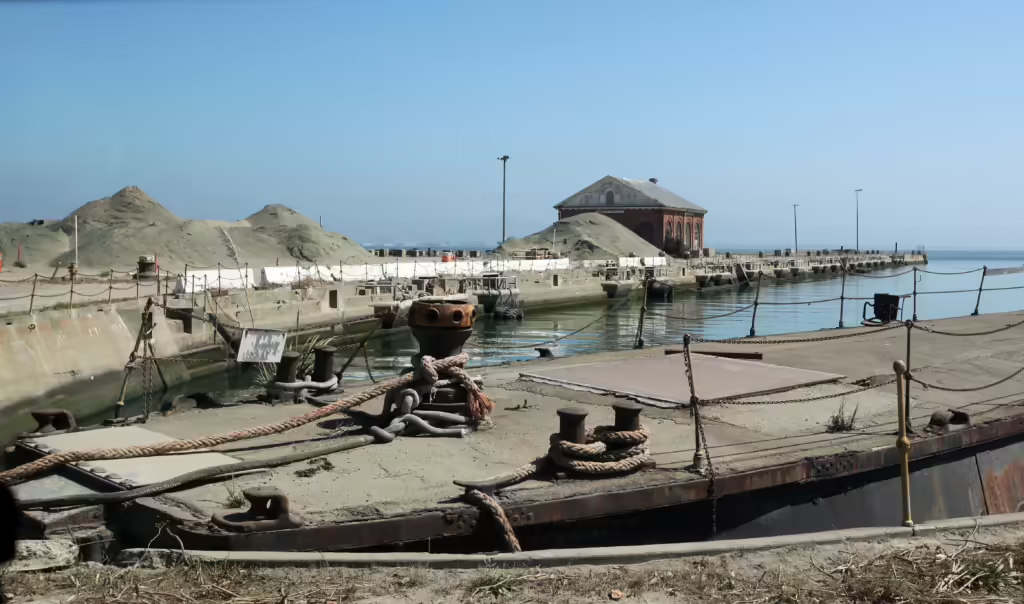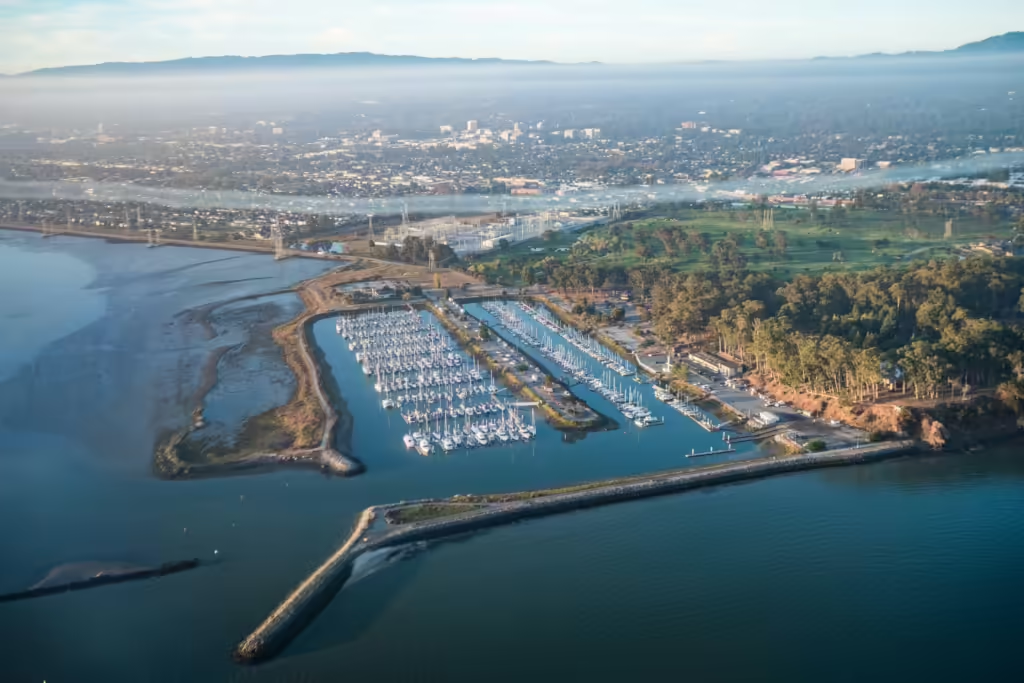A “Brave Proposal” Seeks to Address a Housing Shortage and Rising Sea Levels in the Bay Area

The city of San Francisco, which already faces a housing shortage, also has to address the impact of rising sea levels, according to researchers from the Orfalea College of Business and the College of Architecture and Environmental Design. (Photo/Adobe )
Already critically short, Bay Area housing availability could dramatically worsen with the potentially devastating impact of rising sea levels, said Amir Hajrasouliha, an associate professor in Cal Poly’s College of Architecture and Environmental Design (CAED).
“A lot of the Bay Area will be under water in 50 years,” said Hajrasouliha, who heads CAED’s City and Regional Planning Department. “Especially in North Bay and South Bay, and portions of San Francisco downtown are at risk.”

Associate Professor of Finance Hamed Ghoddusi and his students are focusing on the economic and legal issues related to the project. (Photo/Pat Pemberton)
With that in mind, a team of faculty and students from both CAED and the Orfalea College of Business are researching ways to protect densely populated Bay Area communities from rising sea level (RSL) while also adding land to accommodate needed additional housing.
Specifically, the researchers are looking at two sites along the San Francisco Bay: Hunter’s Point, in the southeast side of San Francisco, near Candlestick Park, and the San Mateo coastline, roughly 20 miles south of San Francisco. By expanding land into the bay at both locations – a process called land reclamation – additional space for homes would be created. But measures would be required to protect that land from seawater, which is expected to rise 0.8 feet by 2050 and 3.1 feet by 2100.
“The idea is to identify sites where filling the body of water in the bay makes sense from various aspects, including environmental, engineering, and economic,” said Hamed Ghoddusi, an associate professor of finance. “The reclaimed land creates a barrier against sea-level rise in the vulnerable areas of the bay, where high-value assets are located.”
The projects at Hunters Point and San Mateo serve as models that could be implemented across the Bay Area and in other urbanized regions of California, including San Diego Bay, Hajrasouliha said.
These projects propose land be added by dredging in the bay – as the Army Corps of Engineers did when it built Treasure Island in the 1930s. But climate change wasn’t a topic of conversation back then.
“What is significant is that it is a region that is facing unprecedented threats from sea level rise, along with earthquakes,” said Adrienne Greve, a professor in CAED’s City and Regional Planning Department. “Accommodating and/or addressing the SLR threats, no matter how you do it, will require new and novel approaches that will require substantial capital investment.”
“Multiple studies suggest that housing constraints in the San Francisco area are limiting GDP growth by restricting the growth of the technology sector there.”
Hamed Ghoddusi, associate professor of finance
Protecting communities with levees, seawalls and other artificial means would be a massive project, likely costing billions, Hajrasouliha said.
Protecting the Bay Area from sea level rise and flooding by 2050 is estimated to cost around $110 billion, with annual funding gaps of $315 to $570 million, according to regional studies by the Metropolitan Transportation Commission, Association of Bay Area Governments, and the San Francisco Bay Conservation and Development Commission.
“It raises the question of how much we should adapt to, resist, or surrender to nature,” he said.
Given the Bay Area’s economic value, Ghoddusi said, it might be worth the investment to both protect communities and even expand them if technical, environmental and legal hurdles can be justified.
“San Francisco has one of the highest house prices in the nation while the most productive sector of the U.S. economy – Silicon Valley – is hosted there,” Ghoddusi said. “Multiple studies suggest that housing constraints in the San Francisco area are limiting GDP growth by restricting the growth of the technology sector there.”
San Francisco’s ports and harbors are also vital to global trade, tourism, and local employment, according to the study, which was funded by an anonymous CAED alumnus.
Meanwhile, in the Bay Area, where the median home cost recently surpassed $2 million, housing supply isn’t meeting demand.
Statewide, California housing prices have also skyrocketed – prices are nearly 2.5 times higher than the median national home, according to the nonprofit news site Cal Matters. Meanwhile, new home construction continues to lag for a host of reasons, including lack of available land.

Hunter’s Point in San Francisco is being cleaned up for development, but rising sea levels have yet to be addressed. (Photo/Adobe)
“California is also known for being strict with environmental regulations as well as a very expensive place to do construction work,” Ghoddusi said.
While officials in San Francisco have already devised a plan to clean up Hunter’s Point, which is contaminated from its shipyard days, and add residential and mixed-use development, the plans neglect to address rising sea levels.
“The best option is to take action ahead of severe flooding occurring,” Greve said.
The study is less a recommendation and more of a concept, Hajrasouliha said. But the team hopes to publicize the work and make it available to relevant agencies.
“Conventional approaches to housing are no longer meeting the demands of our ever-changing world, so we must explore innovative, sustainable solutions.”
Melanie Maher, finance graduate
While land reclamation is nothing new, this study is unique, he said.
“It’s novel because of its scale; It’s a brave proposal.”
For students, the project represents hands-on, experiential learning. Joseph Sanchez, an economics major concentrating on finance, said the research has allowed him to apply economic principles and financial modeling to a real-world challenge.
“It strengthened my ability to work with interdisciplinary teams, synthesize technical data, and communicate complex ideas effectively — all of which are skills that will be invaluable in my future career in finance, economic policies, and research,” he said.
During the project, Sanchez analyzed the economic impacts of sea-level rise on the Bay Area, focusing on vulnerable assets like schools, hospitals, and industrial facilities. “Additionally, I collaborated with the team to review regional policy documents and integrate our findings into actionable recommendations.”

The coastal city of San Mateo is located south of San Francisco. (Photo/Adobe)
Melanie Maher, meanwhile, worked as a research assistant, focusing on legal regulations and financial development.
“I’ve had the opportunity to conduct in-depth research on land use policies, from federal regulation to local ordinances, while also developing proformas and financing strategies,” said Maher, who plans to attend law school and pursue a career in housing development and land use law. “Often, I played a form of devil’s advocate by researching legal barriers and presenting the challenges likely to be faced if the project were to take place.”
The interdisciplinary team, Sanchez said, has explored multiple angles with a variety of expertise.
While the project is expected to last through spring, Sanchez hopes it will inspire cities to take steps to protect their communities from rising sea levels.
“By quantifying the potential economic impacts and exploring solutions like land reclamation, it highlights the importance of proactive planning and investment in resilience,” he said.
The project also offers a potential approach to housing, said Maher, who graduated with a degree in real estate finance last summer.
“Conventional approaches to housing are no longer meeting the demands of our ever-changing world, so we must explore innovative, sustainable solutions,” she said. “The first step is pushing the boundaries of how we view infrastructure and combating stereotypical views on various development methods like land reclamation.”
Your support for Cal Poly’s Finance Area helps faculty and students produce impactful research that explores solutions to contemporary challenges.
